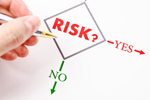ARTICLES BY MARK F. WITCHER
-
Why Pharmaceutical And Medical Device Risks Must Be Analyzed By Their Risk Mechanisms9/16/2025
Current risk analysis methods focus on the possibility and severity of bad events instead of focusing directly on analyzing and improving the performance of systems and processes producing the bad events.
-
Minimizing The Impact Of Human Errors Using Relational Risk Analysis8/4/2025
This article describes how a mechanism-based risk analysis approach can provide two complementary opportunities for minimizing the likelihood of a human error impacting pharmaceutical and medical device risks.
-
Expanding A Bow Tie Risk Analysis Model Using Relational Risk Analysis6/2/2025
Relational risk analysis can be used to enhance and expand a bow tie analysis in the pharma and medical device industries to more effectively analyze risks as relationships between mechanisms and events.
-
Managing Contamination Risks In The Pharmaceutical And Medical Device Industries Using Relational Risk Analysis2/18/2025
Of all the risks associated with pharmaceuticals and medical devices, controlling contamination is one of the most important and difficult challenges. Relational risk analysis (ReRA) can help.
-
A New Approach For Minimizing Human Errors In Biopharmaceuticals And Medical Devices2/3/2025
Human errors account for many manufacturing failures, simply due to the roles in our activities and systems. Relational risk analysis (ReRA) fundamentally changes the way risks are analyzed.
-
System Failure Mode & Effects Analysis (SFMEA): An Alternative Approach For Analyzing Risks6/26/2024
Your company likely uses risk matrices and FMEA for analyzing risks. This article describes an alternative approach for conducting a system failure mode & effects analysis.
-
Managing Supply Chain Risks Using Relational Risk Analysis4/5/2024
In the bio/pharma and medical device industries, you can easily model, understand, and manage supply chain risks using relational risk analysis. Here's how.
-
Designing Highly Agile Bio/Pharma Manufacturing Facilities4/5/2024
In bio/pharma, agile manufacturing is achieved through multipurpose designs that support a variety of unit operations manipulated and operated as independent yet connected modules.
-
Using Relational Risk Analysis To Control Procedure Failures2/15/2024
In the bio/pharma and medical device industries, operating procedures guide virtually every activity and are required for compliance with good manufacturing practices. Minimizing procedure execution failures is critical. To do so, you can use relational risk analysis (ReRA).
-
When In The Product's Life Cycle Does Continuous Manufacturing Make Sense?2/1/2024
This overview article takes a look at each product development stage for bio/pharmaceuticals to illuminate when continuous manufacturing can satisfy important business drivers.
-
Relational Risk Analysis For The Bio/Pharma Industry1/29/2024
Successfully developing and manufacturing biopharmaceuticals depends on identifying, analyzing, and managing a wide variety of risks. This article presents a novel alternative risk analysis approach that provides a simple, easy, and effective method for quickly and efficiently modeling and analyzing any risk.
-
How To Evaluate & Manage Safety Risks In Biopharma5/2/2022
Safety risks can be described and modelled as cause-and-effect relationships using system risk structures. This article structures risks beginning with a defined danger or threat so they can be effectively understood and then managed. Examples include wearing protective gloves (as a simple risk) and handling antibody-drug conjugates (as a complex risk).
-
Using System Risk Structures To Evaluate COVID-19 Pandemic Risks12/15/2021
This article's discussion demonstrates how system risk structures (SRS) can be used to understand complex risks and how SRS might be applied to understand the very complex risk landscape of the COVID-19 pandemic. It includes analysis of risk of personal infection, risk of disease progression or spreading, risk of vaccination, and more.
-
Principles And Concepts Of System Risk Structures For Understanding & Managing Risks12/6/2021
A truly effective risk analysis method for the biopharma industry should provide insights to and understanding of the fundamental properties and attributes that underlie every type of risk. This article describes how system risk structures (SRS) can be used to understand and manage both simple risk situations as well as complex risk landscapes quickly and efficiently.
-
FMEA Vs. System Risk Structures (SRS): Which Is More Useful?9/24/2021
In this article, Mark Witcher, Ph.D., discusses the many failure modes of FMEA and risk priority number (RPN), comparing and contrasting it with system risk structures (SRS) and adjusted risk likelihood (RPN). He concludes that one of these is more useful than the other for pharma and medical devices; which one is it?
-
Using System Risk Structures To Understand And Balance Risk/Benefit Trade-offs4/23/2021
The ICH 31000 guidance defines a risk as the “impact of uncertainty on objectives.” As a follow-up to his article on why we should replace the RPN with the adjusted risk likelihood (ARL), Mark Witcher describes how system risk structures can be used to simultaneously understand and manage both risks and benefits.
-
Rating Risk Events: Why Adjusted Risk Likelihood (ARL) Should Replace Risk Priority Number (RPN)4/7/2021
While the RPN primarily represents a risk event’s severity, perhaps a more important attribute to focus on is the risk event’s likelihood of occurrence. In this provocative article, Mark Witcher, Ph.D., proposes an adjusted risk likelihood rating approach that emphasizes a risk event’s likelihood of occurrence.
-
Revising Annex 1: A Case Study In Controlling Operating Risks By Understanding Uncertainty11/13/2020
Unfortunately, the pharmaceutical industry does not understand how to control a risk’s likelihood of occurrence. The current draft of EU GMP Annex 1 is an example of the industry’s focus on a risk’s severity while not understanding or evaluating a risk’s uncertainty and thus defaulting to using the precautionary principle for guidance.
-
Can We Eradicate Tech Transfer?9/23/2020
While warp-speed manufacturing is a pandemic term, the concept is important to the FDA’s 21st century vision of “a maximally efficient, agile, flexible pharmaceutical manufacturing sector that reliably produces high-quality drugs without extensive oversight.” Reaching 21st century performance requires replacing many 20th century practices.
-
A Functional History Of Process Validation: Part 2 – The Key To A More Effective Future8/14/2020
Part 1 of this two-part series discussed the history and underlying concepts of process validation (PV), which is required for dealing with the increasingly sophisticated pharmaceutical manufacturing processes necessary for realizing advanced medical therapies. This article describes how PV concepts can be evolved so the industry can better develop, manufacture, and launch the next generations of biopharmaceutical products.
-
A Functional History Of Process Validation, Part 1 – A Weak Foundation8/7/2020
This article is the first of a two-part series that describes the origins of process validation to explain the underlying concepts necessary to control the advanced bioprocess manufacturing technologies required to make the next generations of biopharmaceutical therapies.
-
System Risk Structures: A New Framework For Avoiding Disaster7/13/2020
Risks are ubiquitous, occurring in every aspect of our personal and professional lives. This article describes how pharmaceutical development and manufacturing risks can be easily understood and effectively managed using straightforward concepts.
-
What Managing Personal SARS-CoV-2 Risks Can Teach Us About Managing Pharma Risks6/12/2020
This article describes how the basic principles of managing personal risks of being infected by a respiratory virus can be used to manage risks for developing and manufacturing pharmaceuticals. The goal is to elucidate the basic principles of understanding, managing, and communicating a wide variety of risks from the trivially simple to the very complex.
-
2 (Major) Impediments To Faster Biopharma Product Development5/29/2020
As pharma products have become more complicated, companies have become bogged down in accomplishing their mission of launching new products because of complex regulatory requirements, convoluted management approaches, and inefficient resources and methods that add time and cost to moving new products from research to patients.
-
Can Biosimilars Be The Bridge To More Widespread Continuous Bioprocessing?5/19/2020
This article will examine the relationship between improved continuous manufacturing (CM) and biosimilar development, paying particular attention to the reasons why biosimilars are especially promising candidates for CM development and innovation.
-
Why Controlling CQAs Isn't Good Enough For Gene & Cell Therapies3/31/2020
It's frequently stated in the biopharma industry that to control a product’s critical quality attributes (CQAs) one must control the process’ critical process parameters (CPPs). While the statement is accurate literally, it does not convey the true technical requirements for controlling product quality.
-
Straightforward, Risk-Based Approach To Better Quality Management Design3/18/2020
As biopharma products and processes gain complexity, so does the design and implementation of the QMS' necessary to support development and manufacturing. This article describes an approach for building a QMS based on the identification of risk exposed to the product, manufacturing process, employees, and patients during development and manufacturing.



























